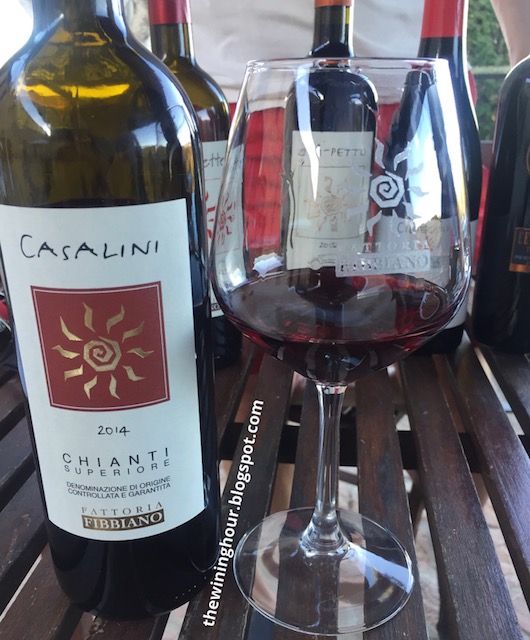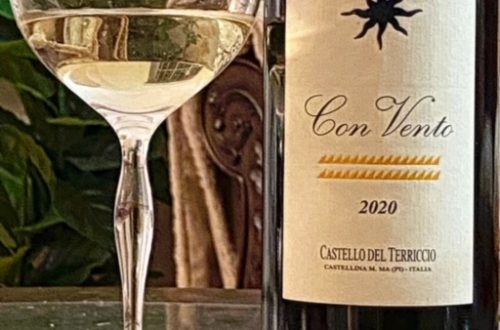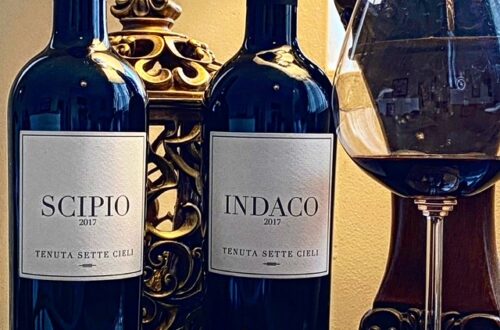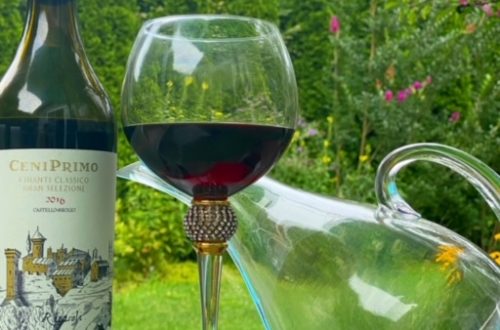Quality Wine-making in Terricciola, the City of Wine
 |
| Photo Credit: Fattoria Fibbiano |
The ancient Etruscan hillside village of Terricciola is in Italy’s Tuscan region, in the Province of Pisa, about 50 kilometers from Florence, in between Pisa and Volterra. The name Terricciola may be derived from the Latin word ‘terra’ (earth) or ‘turris’(tower), referring to the towers built in the 12th century to defend the village. Although having a small population of approximately 5000 people, Terricciola is known for its agriculture, art, architecture…and wine. In fact, it is known as the “City of Wine’ due to its conducive terroir. The Notte Bianco del Vino is celebrated in July, and in September, Terricciola hosts its annual Festa dell’Uva e del Vino (Grape and Wine festival),where all of the village’s wines and produce are featured and celebrated. There are several other festivals and plenty of places to enjoy excellent wine in Terricciola. Fattoria Fibbiano is a great choice.
 |
| Hillside in Terricciola, Tuscany |

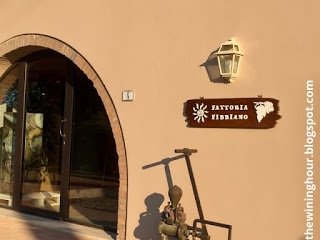
It was not too long ago that I found myself at Fattoria Fibbiano in Terricciola. One lazy Sunday, I visited Fattoria Fibbiano, along with my good friend, Katarina Andersson, of GrapeVine Adventures. We had the pleasure of spending the day with the owner and wine-maker, Matteo Cantoni, and his family.
Upon our arrival, we engaged in casual banter with Matteo about the beauty of Italy, wine, wineries and life in general. We were then invited to cool off with a taste of Fattoria Fibbiano Morfeo Sparkling Rosé. Morfeo Sparkling Rosé is a spumonti, made via the metodo classico method. It is made with 100% Sangiovese grapes, which only had skin-contact for approximately 12 hours or less. Morfeo is a light, copper with salmon-colored flecks. Morfeo is very aromatic and refreshing with light raspberry on the palate and persistent perlage. Just what we needed under the warm Tuscan sun! After we sipped our bubbles and cooled our palates, we were further refreshed by a swim in their beautiful pool. Friends, family and visitors all enjoyed the warmth of the Italian sun and pool.

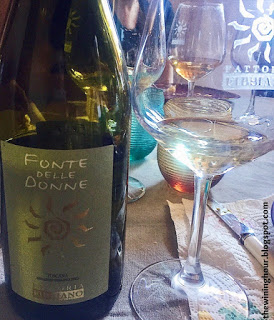
Wow, swimming and drinking sparkling rosé really works up an appetite! We then had an intimate lunch with the family, which was paired with Fattoria Fibbiano Fonte Delle Donne IGT. Fonte Delle Donna, named after a fountain (woman’s fountain) that exists on the estate, is 50% Colombana and 50% Vermentino, grown in mainly sandy soil, rich with marine shells. The grapes for Fonte Delle Donna are manually harvested and then placed in tanks cooled down by iced CO2. After 24 hours and once the appropriate temperature is reached, the must is transferred and the wine is allowed to mature in stainless steel. The 2015 Fonte Della Donna is a pale golden yellow color, with fruity aromas of apple and tropical fruit. The coral and marine shells bring help the wine to demonstrate excellent minerality. It was a great accompaniment for a typical lunch of antipasto and pasta.

It was now time to burn some calories, explore the vineyards and learn more about the wine-making practices. First, I appreciated that fact that Fattoria Fibbiano is certified organic. Their practices, farming and wine-growing methods are truly natural. Everything is treated with organic fertilizers, grapes are harvested manually and there is minimum human interaction, because they believe “everything else depends on the power of nature.” Fibbiano even uses their own wood for central heating. Further, this sustainable winery has implemented a solar plant to conserve energy and produce fresh water. A tour of the cellar, tanks and bottling room further emphasized their sustainability.


The vineyards had a mixture of old vines and new vines to keep the vineyard alive, with red grapes planted on the top of the hill, and white grapes on the lower parts. When I visited Fattoria Fibbiano, most of the country was experiencing drought conditions. While all of the vineyards were clearly in need of water, Matteo maintains that this is good for the grapes. “The grapes need to suffer.” When the grapes suffer, they really have to dig deep to extract nutrients, and this absolutely builds character leading to better, higher quality wines. I experienced this truth first-hand all over the Tuscan region last year! Matteo also shared his three secret ingredients for great wine: “Sun, soil and patience.”



The soil is a mixture of clay and limestone. Due to Fibbiano’s proximity to the Mediterranean and Ligurian seas, it wasn’t hard to explain why there were also seashells in the vineyard soils. In fact, Terricciola’s soil is similar to that of Chianti Classico, so it was fascinating to see exactly how Matteo works with Sangiovese, the Italian superstar grape. In terms of climate, Terricciola has warm sea breezes during the day and cooler nights, which helps the grapes to retain acidity and develop flavor. The altitude of the Colli Pisane, the soil and the micro-climate contributes to more full-bodied wines with minerality, great acidity and aging capability. Not did I appreciate seeing, touching and smelling the soil as I learned about the terroir of Terricciola, I was also moved to see how passionate Matteo is about is his land.
 |
| Winemaker, Matteo and the soil at Fattoria Fibbiano |
 |
| Matteo Cantoni and Me |
Our walk through the vineyards, coupled with the Tuscan sun, had us ripe and ready to taste some more of Fibbiano’s fruitage. A bountiful tasting of Fattoria Fibbiano wines and a delicious dinner followed. Here’s what else we tasted from Fattoria Fibbiano in the Colli Pisane (Pisa Hills):
Fattoria Fibbiano Le Pianette IGT
La Pianette is produced from 70% Sangiovese and 30% Colorino grapes in clay soil. After manual harvest, the must goes in stainless steel tanks for about a week and then matures in Slavonian oak. Classic Sangiovese-esq ruby color, baking spices on the nose and cherry on the palate. Smooth tannins. Fibbiano is big on preserving the history of the region and its indigenous grapes, and La Pianette does so very well.
Fattoria Fibbiano Casalini Chianti Superiore DOCG
Casalini would delight any lover of Chianti. 80% Sangiovese and 20% Ciliegiolo. After manual harvesting, destemming and resting in stainless steel, the wine is aged in Slavonian oak for 8 months where malolactic fermentation occurs. It is then bottled for 3 months. Casalini Chianti Superiore is ruby red in color with intense aromas of cherry, raspberry and blackberry. The palate is full of dark, ripe berries, vanilla and spice. The earthy, clay pot notes are evident as well. As some Chianti wines can be quite light-bodied, Fibbiano’s Chianti is more full-bodied, with a multi-layered complexity, elegant, with fine tannins and a persistent finish.
Fattoria Fibbiano Ciliegiolo IGT
Made from 100% Ciliegiolo is high in acidity, low in sugar and not too fruity. Yet, one can still detect raspberry, blackberry and cherry on the palate with herbal, balsamic undertones. Of note, is that Ciliegiolo means “cherry” in Italian, and the grapes are similar in size, smell and taste. Ciliegiolo refers to the red grape which is typically used from blending, and has some relation to sangiovese. However, Fattoria Fibbiano has crafted it into a bigger, more structured wine.
Fattoria Fibbiano L’Aspetto IGT
Ahhh, L’Aspetto. L’Aspetto is made with a higher percentage of Caniaolo than usual, as it is 50% Sangiovese and 50% Caniaolo from mainly clay soil, rich with marine shells. The Sangiovese grapes are from old vines. L’Aspetto is an intense ruby color and is very aromatic with aromas of anise, blueberry, raspberry and tobacco and a palate of spicy raspberry. This blend gives the wine a balsamic complexity that is rich and keeps you wanting more. Interestingly, l’aspetto in Italian, means the aspect, feature, characteristic or detail. Fibbiano’s L’Aspetto has is a great example to demonstrate the aspects or features of the region and of excellent winemaking.
Fattoria Fibbiano Cepatella Terre di Pisa DOC
Terre di Pisa is a new DOC for Pisa, and was recently established in 2011. Cepatella showcases it well. Made with 100% Sangiovese grapes from 100 yr. old vines with deep, deep roots. The DOC aging requires a minimum of 16 months, including 12 months in barrel and 4 months in the bottle. Cepatella aged for 6 months in tonneau, an additional 14 months in Slavonian oak and then bottle refinement for another 5 months. I tasted the 2012 vintage, which is an intense ruby red color, with persistent aromas of spicy cherry, tobacco, leather, coffee and vanilla. The palate is warm with cherry and chocolate. Soft mineral undertones and a persistent finish.
 |
| Old Vines at Fattoria Fibbiano |

So there you have it: authenticity, passion and organic wines of quality. Yet, wine is not the only thing that Fattoria Fibbiano does well. They are awesome hosts and offer awesome
hospitality and agriturismo. The accommodations are beautiful at their country estate, which includes over 75 hectares of vineyards, olive groves, wheat fields and woodlands. They also have a new
wine bar! For great food, wine, relaxation, culture, nature, tours, cooking classes and total immersion in Tuscan traditions and gastronomy, Fattoria Fibbiano is a great choice.
It was a real pleasure to experience Terricciola and the wines of Fattoria Fibbiano. It is not hard to see why it is called the City of Wine or why the wines are so fantastic. Matteo, is truly a wine-maker with a heart as large as his terroir. For excellent quality, organic wines in Tuscany, taste
Fattoria Fibbiano.Check out Chianti Superiore: A Wine with Many Faces where Fattoria Fibbiano is also featured!

















